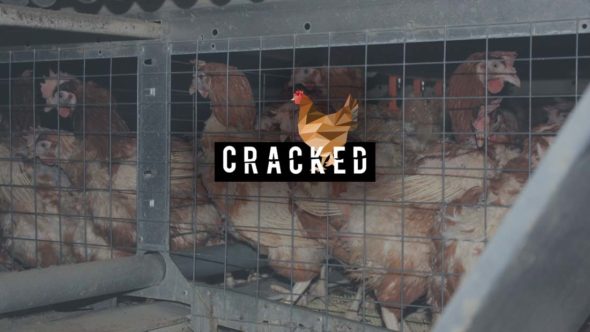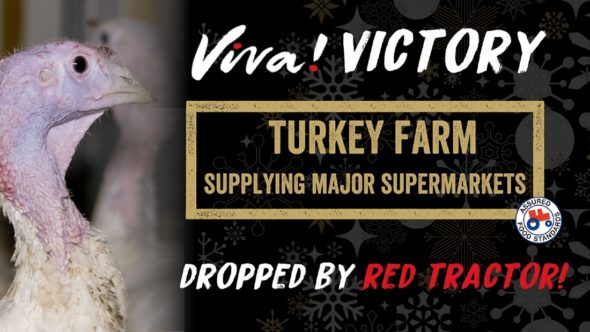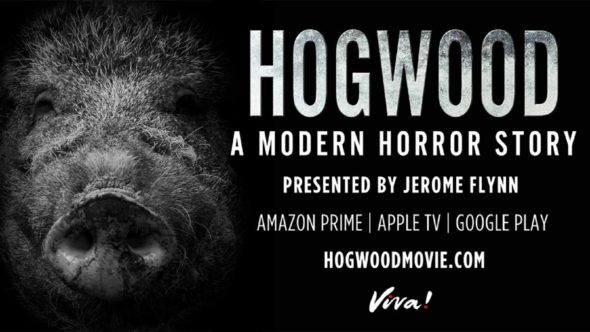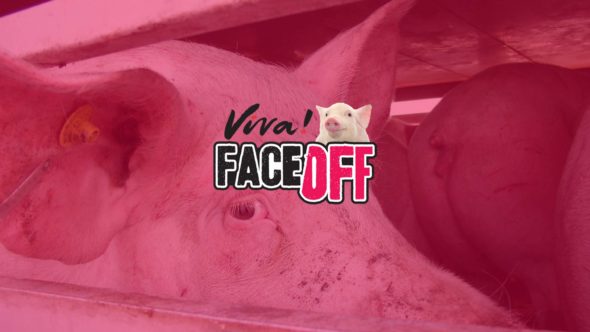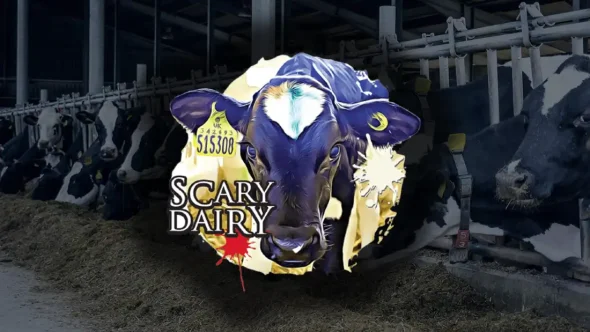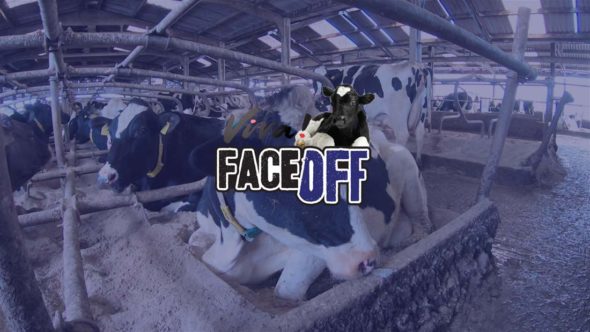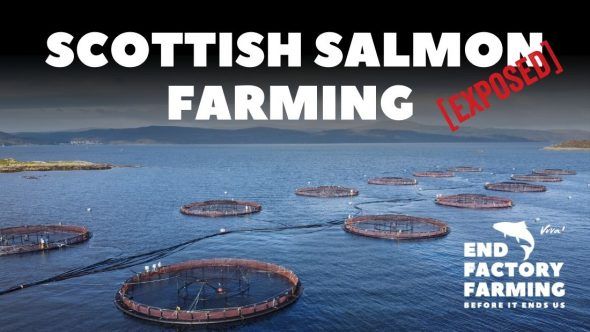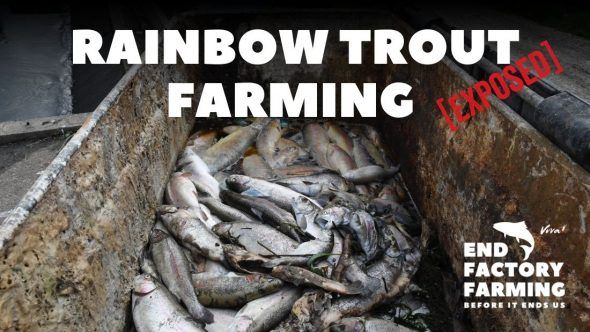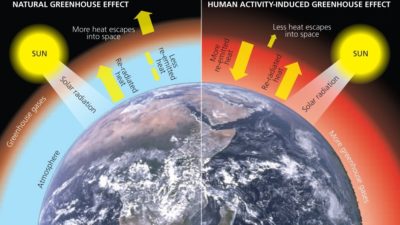Introduction to Factory Farming

More than 100 billion animals globally are killed for meat, dairy and other animal products every year. That’s hundreds of millions every single day. This amounts to a huge amount of suffering but is made even worse by the fact that the vast majority of them spend their lives living in filthy, overcrowded and stressful conditions. In other words, they are kept in factory farms.
Factory farming is a modern system of farming animals which uses highly intensive methods which prioritise profit above all other considerations. The UK has over 1,800 factory farms and the number has been increasing in recent years. In these farms, animals are kept in cramped, overcrowded conditions with a lack of environmental enrichment, poor hygiene standards and low animal welfare.
There is no specific definition of a ‘factory farm’. In the UK, environmental agencies call livestock farms ‘intensive’ if they house over 40,000 chickens, 2,000 pigs or 750 sows. Dairy and beef cattle farms are not regulated in the same way and there’s no formal definition of what constitutes an intensive cattle farm.
In the US, the term ‘mega-farm’ is used to describe factory farms holding more than 125,000 birds reared for meat or 82,000 egg-laying hens, 2,500 pigs, 700 dairy cows or 1,000 beef cattle. Officially, they are referred to in the US as ‘concentrated animal feeding operations’ (CAFOs).
Globally, it’s estimated that three-quarters (74 per cent) of livestock are factory-farmed. That means that at any given time, around 23 billion animals are confined on these farms.1Our World in Data. 2025. How many animals are factory-farmed? Available at: https://ourworldindata.org/how-many-animals-are-factory-farmed.
Although conditions vary between countries and animals, there is one unifying factor in all factory farming in that it is wholly unnatural. Over the past century animal farming has changed from family run small holdings, to a ruthless profit-driven machine – an industrialised, fast-moving production line that prioritises profit over the welfare of animals, humans and the planet.
Instead of grazing on fields, animals are now confined in their thousands, sometimes millions, in giant metal sheds condemned to a life where they will never feel the grass under their feet or the sun on their face. Selective breeding for maximum production causes immense suffering as animals struggle to carry the weight of their oversized bodies or milk-filled udders. Disease and injury run rife meaning that animals need to be propped up on a cocktail of antibiotics and drugs just to keep them alive long enough to slaughter, or to keep taking their milk.
Factory farming is a disaster, for animal welfare, the environment and human health. It also poses a pandemic threat and increases the risk of antibiotic resistant superbugs.
By far the most factory farmed land animal in the world is the chicken. There are at least 26 billion chickens alive in the world at any one time – more than three times the number of people.2Our World in Data. 2025. Number of chickens, 1961 to 2022. Available at: https://ourworldindata.org/explorers/animal-welfare In 2023, over 76 billion chickens were killed across the world.3FAOSTAT. 2025. Crops and livestock products. Available at: https://www.fao.org/faostat/en/. The vast majority of them would have been confined in vast overcrowded sheds for their short, miserable lives.
At least half of the world’s pigs are factory farmed – many will be born inside metal crates and incarcerated for the rest of their short lives before being taken to slaughter.4Compassion in World Farming. 2025 Pig Welfare. 2015. Available at: https://www.ciwf.org.uk/farm-animals/pigs/pig-welfare/
Cows too are factory farmed – for both their milk and meat. Most factory-farmed cows never get to go outside, they are confined to indoor sheds that are often filthy and overcrowded. They’re denied the opportunity to graze, lie comfortably, tend their young, or live in socially complex herds with their offspring.5The Humane League. 2021. Factory-farmed cows: what happens to cattle on factory farms? Available at: https://thehumaneleague.org/article/factory-farmed-cows
Although the main animals we think of as being factory farmed are chickens, pigs and cows, huge numbers of other species including rabbits, ducks, turkeys and other poultry as well as fish and shellfish are also factory farmed.
The farming of fish (aquaculture) echoes the dismal and unnatural conditions that factory farmed livestock are kept in. Fish farming is often overlooked, but in 2022, aquaculture production surpassed that of capture fisheries – more fish came from fish farms than from seas and rivers. Of the 185 million tonnes of aquatic animals produced in 2022, 51 per cent (94 million tonnes) was from aquaculture and 49 per cent (91 million tonnes) from capture fisheries.6Food and Agriculture Organisation of the United Nations (FAO). 2018. The State of the World Fisheries and Aquaculture 2024. Available at: https://www.fao.org/publications/home/fao-flagship-publications/the-state-of-world-fisheries-and-aquaculture/en
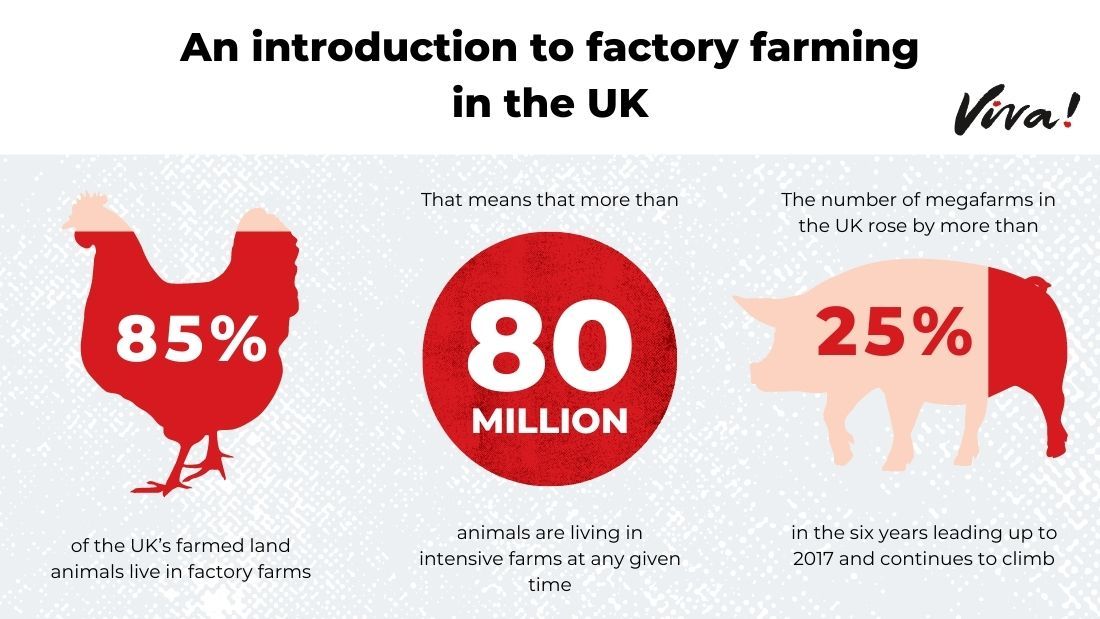
Whilst it is often claimed that the UK has some of the highest welfare standards in the world, the tragic reality is that at any one point in time, over 80 million animals are living in UK factory farms. Many of them are killed and replaced when just a few weeks or months old. This means that over a billion animals spend their short lives confined in factory farms every single year – that’s 85 per cent of all UK farmed animals and numbers are rising.1Compassion in World Farming. 2025. Factory farms are rising across the UK. Available at: https://www.ciwf.org.uk/our-campaigns/factory-farming-map/
From smallholdings to megafarms
The traditional image of British farming is one of cows grazing lazily on rolling hills, chickens clucking happily in grassy meadows. This image of so-called rural perfection, portrayed on milk cartons and free range egg boxes bears very little resemblance to the reality of modern farming in the UK today.
The stark truth is, to produce the billions of sausages, burgers, eggs and litres of milk to feed the British public’s appetite for animal products, livestock farming is becoming ever more industrialised. The more animals that can be ‘processed’ in the shortest time on the least amount of land, the cheaper their products become. The biggest factory farms can house more than a million chickens, 20,000 pigs or 2,000 dairy cows, in expansive factory units.
According to the research, the number of factory farms in the UK increased by 209 between 2017 and 2024, totalling a shocking 1,821.2World Animal Protection UK. 2024. UK animal cruelty hits record highs due to continued rise in factory farming. Available at: https://www.worldanimalprotection.org.uk/latest/news/confined-in-cruelty
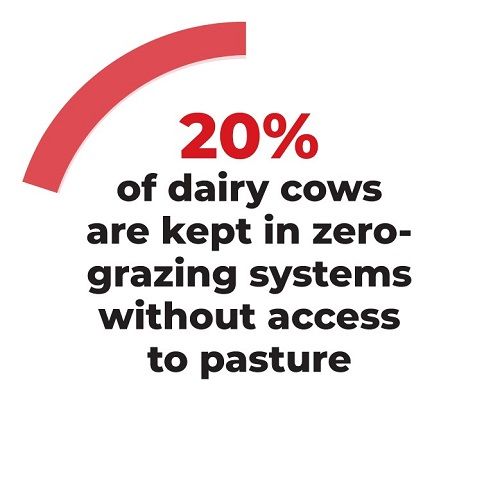






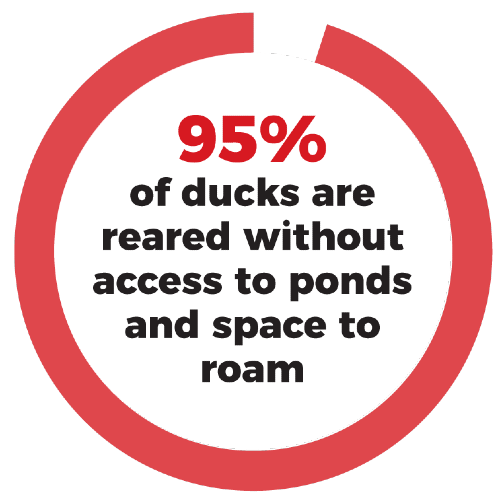


Poultry
Over 95 per cent of chickens reared for meat in the UK are intensively reared, living in crowded, giant sheds where they will never get to see the light of day. Their short life is cruel and painful – from birth to death in only six to seven weeks. They are selectively bred to grow so quickly that their bones can’t support their weight.
For 42 per cent of egg-laying hens their lives will be spent caged,1Egginfo.co.uk. 2020. UK Egg Industry Data|Official Egg Info. Available at: https://www.egginfo.co.uk/egg-facts-and-figures/industry-information/data [Accessed 1 May 2020]. many of the rest live in industrial-scale ‘free range’ farms where they never venture outdoors.
Poultry farms are the biggest intensive farms in the UK housing huge numbers of birds in cramped conditions. Seven out of the 10 largest poultry farms in the UK house more than one million birds.2Wasley, A Harvey, F, Davies, M and Child, D. 2017. UK has nearly 800 livestock mega farms, investigation reveals. Available at: https://www.theguardian.com/environment/2017/jul/17/uk-has-nearly-800-livestock-mega-farms-investigation-reveals
It’s not just chickens either – the vast majority of other poultry such as ducks and turkeys are also factory farmed. Ducks have no access to water for swimming or preening and like broiler chickens and turkeys, are kept in giant-sized sheds in their tens of thousands.
Factory farmed chickens, turkeys and ducks are some of the most abused animals on earth, and that’s no different in the UK. Viva!’s investigations have uncovered broiler chickens, egg laying hens, turkeys and ducks in appalling states – injured, diseased, disfigured. Many are left to die in dark overcrowded sheds, all of which supplied major UK supermarkets.
Pigs
Most pigs are factory farmed in the UK. Only two per cent of pigs will get to spend the entirety of their lives outside.3CPRE.org.uk. 2019. The future of pig and poultry farming. Available at: https://www.cpre.org.uk/wp-content/uploads/2019/11/The_future_of_pig_and_poultry_farming.pdf Almost all pigs, even if they are born in outdoor systems, will be moved to indoor finishing sheds when they are only 10 weeks old. Almost two thirds of mother pigs are still forced to give birth in crates in the UK.
Pigs are one of the most intelligent species on the planet and yet we condemn most of them to conditions that would not look out of place in a horror film.
Viva! have carried out dozens of high profile investigations into pig farms in the UK, exposing horrendous conditions and suffering including cannibalism, diseased, injured, and dying pigs and dead pigs left to rot on factory farm floors.
Aside from the obvious animal welfare issues of factory farming pigs, there are also severe risks when it comes to pandemics. The Swine flu pandemic of 2009 killed hundreds of thousands worldwide, and scientists warn that a pandemic beginning in a pig farm is a very real threat.4Cohen, J. 2020.Swine flu strain with human pandemic potential increasingly found in pigs in China. Available at: https://www.sciencemag.org/news/2020/06/swine-flu-strain-human-pandemic-potential-increasingly-found-pigs-china [Accessed 23 September 2020]
Dairy Cows
Despite the myth of contentment, a dairy cow is the hardest worked of all farmed animals. She nurtures a growing baby inside her while simultaneously producing milk – an average 26 litres (46 pints) per day. To keep the flow going, she is forcibly impregnated every year and her babies are taken away a day or two after birth – year, after year, after year. All calves are taken away from their mothers between 12 and 48 hours after birth.
A dairy cow spends seven months of every year both pregnant and producing large quantities of milk at the same time. This enormous physical demand means that diseases such as mastitis (inflammation of the udders) affect 38 to 50 per cent of dairy cows and is a major reason they are killed young.8Cattle Health and Welfare Group, 2016. Third Report of the GB Cattle Health & Welfare Group [online]. Available from: http://beefandlamb.ahdb.org.uk/wp-content/uploads/2016/12/CHAWG-Third-Report-2016-051216.pdf [Accessed 6 January 2019].
Cows, however, are generally not considered to be factory farmed in the UK as they are allowed to graze outdoors for at least six months of the year. However, this is changing – approximately 20 per cent of dairy farms now use zero or severely restricted grazing systems and it is likely that the trend will increase as profit is placed before the cows’ wellbeing.14 Compassion in World Farming. 2016. The Grass is Greener – The Plight of Dairy Cows. Available at: https://www.ciwf.org.uk/news/2016/04/the-grass-is-greener-the-plight-of-uk-dairy-cows-f1
Fish
In terms of numbers of animals, fish are the second largest to be slaughtered for food in the UK, after chickens.5Mood, A., 2017. ‘Estimated numbers of individuals in aquaculture production of fish species’. Fishcount. Available at http://fishcount.org.uk/studydatascreens2/2017/numbers-of-farmed-fish-B0-2017.php?countrysort=United%2BKingdom%2Fsort2 [Accessed 28 April 2020]. The most commonly farmed species in the UK is the Atlantic salmon with around one million salmon meals eaten every day in Britain.6Adams, L., 2019. ‘Is there a problem with salmon farming?’. BBC News 20 May. Available at https://www.bbc.co.uk/news/uk-scotland-48266480 [Accessed 28 April 2020]. One hundred per cent of Scottish Atlantic salmon are reared on intensive fish farms. Their innate desire to migrate and swim free, completely thwarted.
Much like land-based factory farms, fish farms restrict fish from being able to carry out their natural behaviours. They are often dirty and overcrowded and fish suffer from a range of serious welfare issues, particularly infestations of flesh eating lice.
Fish farms also come with a heavy environmental cost – they pollute and contaminate coastal waters, and as every pound of farmed salmon consumes around three pounds of wild-caught fish as food, there are far more lives lost.7Gross, L., 2008. ‘Can Farmed and Wild Salmon Coexist?’. PLoS Biology 6 (2) e46. Available at https://journals.plos.org/plosbiology/article?id=10.1371/journal.pbio.0060046 [Accessed 28 April 2020].
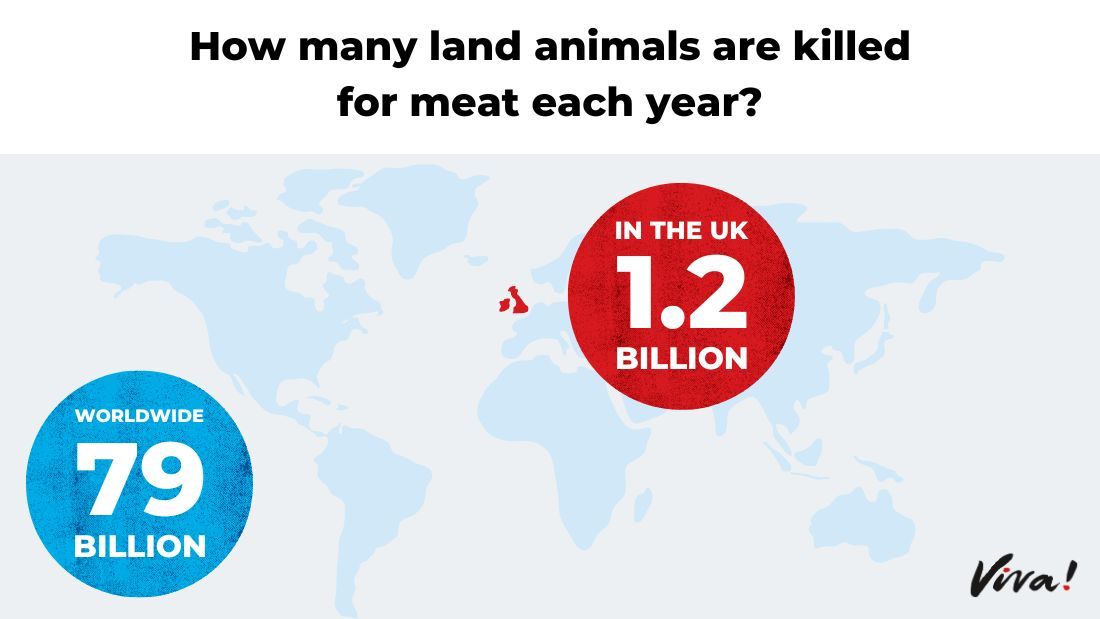
Globally, 79 billion animals (excluding fish) are killed for meat every year. If you add fish and shellfish to this, the number becomes unfathomable and is in the trillions. Of these land animals it is estimated that about three quarters are factory farmed1Anthis, JR. 2019. US Factory Farming Estimates. Available at: https://www.sentienceinstitute.org/us-factory-farming-estimates [Accessed 15 November 2020]. – imprisoned and robbed of the ability to fulfill their natural behaviours. Almost half of all fish eaten globally are from intensively farmed fish.2Food and Agriculture Organisation of the United Nations (FAO), 2018. The State of the World Fisheries and Aquaculture. Available at http://www.fao.org/3/i9540en/I9540EN.pdf [Accessed 15 November 2020]. This number has been growing rapidly over recent decades to meet the demand from a soaring world population.
In some countries, such as the US, up to 99 percent of animals are factory farmed, kept in conditions much worse than any prison for the entirety of their short lives – their only crime to be born into their species.1Anthis, JR. 2019. US Factory Farming Estimates. Available at: https://www.sentienceinstitute.org/us-factory-farming-estimates [Accessed 15 November 2020].
Factory farming is bad news for animals, the planet and for our health. It is widely acknowledged that farming animals is unsustainable and risks disastrous consequences in the coming decades.
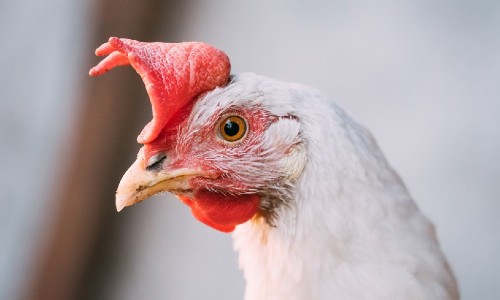
Animal welfare
Intensive farming robs animals of the ability to carry out any of their natural behaviours. Pigs will never root in the ground or bathe in the mud, dairy cow mothers will never nurse their calves, ducks are denied their most fundamental needs – to be able to swim, feed and play on water.
All mother animals have their young ripped from them. Most factory farmed animals are killed as babies. No farmed animal wants to die.
Factory farming create stressed, injured, and diseased animals that are then packaged up and sold in supermarkets – often marketed as ‘high welfare’ or Red Tractor approved.

Environmental impact
The environmental impact of factory farming is colossal. Factory farms are a major contributor of greenhouse gas emissions – accounting for around 20 per cent of the world’s total 1 Xu X, Sharma P, Shu S et al. 2021. Global greenhouse gas emissions from animal-based foods are twice those of plant-based foods. Nature Food. 2, 724-732. Available at: http://www.fao.org/3/a-a0701e.pdf . It is also incredibly water intensive – not only to rear the animals themselves but to irrigate the crops that they are fed.
Intensive farms pollute rivers and lakes causing algal blooms which suffocate waterways and destroy entire ecosystems.
Factory farming is also a major cause of deforestation – a third of the world’s cereal harvest is fed to industrially-reared animals – much of which is grown on deforested land.

Public Health
Factory farming is one of the biggest threats to global health. From chronic disease, to future pandemics and the constant underlying threat of antibiotic resistance, we need to end factory farming before it ends us.
About three quarters of the world’s antibiotics are fed to farmed animals, largely to ward off diseases inevitable under intensive conditions. Antibiotic resistance is an ever-looming threat and it is predicted that if we carry on the way we’re going, it could kill more people worldwide than cancer by 2050. 2 Walsh, F. 2014. Superbugs to kill ‘more than cancer’ by 2050. Available at: https://www.bbc.co.uk/news/health-30416844
Meanwhile pandemics, even more deadly the Covid-19, are ready to spring up from the ideal environments that factory farms create for them to thrive.





